Which Statement Best Describes Engraving


Engraving is the practise of incising a pattern onto a difficult, usually apartment surface by cutting grooves into it with a burin. The upshot may be a busy object in itself, as when silver, gold, steel, or glass are engraved, or may provide an intaglio printing plate, of copper or another metal, for printing images on paper as prints or illustrations; these images are also chosen "engravings". Engraving is one of the oldest and most important techniques in printmaking. Wood engraving is a grade of relief printing and is not covered in this article.
Engraving was a historically important method of producing images on paper in artistic printmaking, in mapmaking, and also for commercial reproductions and illustrations for books and magazines. It has long been replaced by diverse photographic processes in its commercial applications and, partly because of the difficulty of learning the technique, is much less common in printmaking, where it has been largely replaced past carving and other techniques.
"Engraving" is as well loosely but incorrectly used for whatever onetime black and white print; it requires a degree of expertise to distinguish engravings from prints using other techniques such as etching in particular, but also mezzotint and other techniques. Many old principal prints too combine techniques on the aforementioned plate, further confusing matters. Line engraving and steel engraving comprehend utilise for reproductive prints, illustrations in books and magazines, and similar uses, mostly in the 19th century, and often not actually using engraving. Traditional engraving, by burin or with the utilize of machines, continues to exist practised by goldsmiths, glass engravers, gunsmiths and others, while modern industrial techniques such equally photoengraving and laser engraving have many of import applications. Engraved gems were an of import art in the aboriginal world, revived at the Renaissance, although the term traditionally covers relief too as intaglio carvings, and is essentially a co-operative of sculpture rather than engraving, equally drills were the usual tools.
Terms [edit]
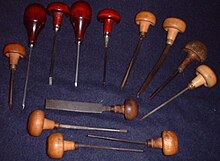
An assortment of hand engraving tools
Other terms often used for printed engravings are copper engraving, copper-plate engraving or line engraving. Steel engraving is the same technique, on steel or steel-faced plates, and was mostly used for banknotes, illustrations for books, magazines and reproductive prints, letterheads and like uses from about 1790 to the early 20th century, when the technique became less popular, except for banknotes and other forms of security printing. Especially in the past, "engraving" was often used very loosely to comprehend several printmaking techniques, so that many so-chosen engravings were in fact produced past totally different techniques, such every bit etching or mezzotint. "Hand engraving" is a term sometimes used for engraving objects other than printing plates, to inscribe or decorate jewellery, firearms, trophies, knives and other fine metal appurtenances. Traditional engravings in printmaking are likewise "hand engraved", using just the same techniques to brand the lines in the plate.
Process [edit]

At an engravers workshop: Miniature engraving on a Louis George watch move: Smallest engraving of the regal Prussian hawkeye on a watch movement. It takes about 100 passes to create the figure.
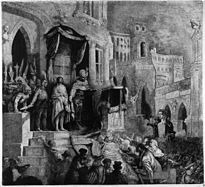
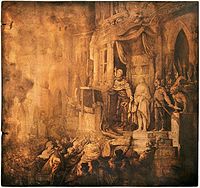
Each graver is unlike and has its own utilise. Engravers use a hardened steel tool called a burin, or graver, to cut the design into the surface, most traditionally a copper plate.[1] However, modern manus engraving artists use burins or gravers to cutting a variety of metals such equally silver, nickel, steel, brass, gilt, titanium, and more, in applications from weaponry to jewellery to motorcycles to constitute objects. Mod professional person engravers tin engrave with a resolution of upwardly to 40 lines per mm in high form work creating game scenes and scrollwork. Dies used in mass product of molded parts are sometimes hand engraved to add special touches or certain data such as part numbers.
In improver to hand engraving, there are engraving machines that crave less human finesse and are not directly controlled past hand. They are usually used for lettering, using a pantographic system. There are versions for the insides of rings and also the outsides of larger pieces. Such machines are unremarkably used for inscriptions on rings, lockets and presentation pieces.
Tools and gravers or burins [edit]
Gravers come in a variety of shapes and sizes that yield different line types. The burin produces a unique and recognizable quality of line that is characterized by its steady, deliberate appearance and clean edges. The angle tint tool has a slightly curved tip that is commonly used in printmaking. Florentine liners are apartment-bottomed tools with multiple lines incised into them, used to do fill work on larger areas or to create uniform shade lines that are fast to execute. Band gravers are made with particular shapes that are used by jewelry engravers in club to cut inscriptions inside rings. Flat gravers are used for make full work on letters, every bit well as "wriggle" cuts on most musical instrument engraving work, remove background, or create bright cuts. Pocketknife gravers are for line engraving and very deep cuts. Round gravers, and flat gravers with a radius, are commonly used on silvery to create brilliant cuts (also called bright-cut engraving), as well equally other difficult-to-cutting metals such as nickel and steel. Foursquare or V-point gravers are typically square or elongated diamond-shaped and used for cutting direct lines. 5-point can be anywhere from 60 to 130 degrees, depending on purpose and effect. These gravers have very minor cutting points. Other tools such as mezzotint rockers, roulets and burnishers are used for texturing effects. Burnishing tools can also exist used for certain stone setting techniques.
Musical instrument engraving on American-made brass instruments flourished in the 1920s and utilizes a specialized engraving technique where a flat graver is "walked" across the surface of the instrument to make zig-zag lines and patterns. The method for "walking" the graver may also be referred to as "wriggle" or "jerk" cuts. This technique is necessary due to the thinness of metal used to brand musical instruments versus firearms or jewelry. Wriggle cuts are unremarkably establish on silvery Western jewelry and other Western metal work.
Tool geometry [edit]
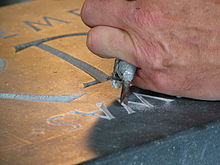
Tool geometry is extremely important for accuracy in hand engraving. When sharpened for well-nigh applications, a graver has a "face up", which is the summit of the graver, and a "heel", which is the bottom of the graver; non all tools or awarding require a heel. These two surfaces meet to class a point that cuts the metal. The geometry and length of the heel helps to guide the graver smoothly as it cuts the surface of the metal. When the tool's bespeak breaks or chips, even on a microscopic level, the graver tin can go hard to command and produces unexpected results. Modern innovations have brought almost new types of carbide that resist chipping and breakage, which concord a very sharp point longer between resharpening than traditional metallic tools.
Tool sharpening [edit]
Sharpening a graver or burin requires either a sharpening stone or bicycle. Harder carbide and steel gravers crave diamond-grade sharpening wheels; these gravers can be polished to a mirror finish using a ceramic or bandage iron lap, which is essential in creating bright cuts. Several low-speed, reversible sharpening systems made specifically for mitt engravers are bachelor that reduce sharpening time. Fixtures that secure the tool in place at certain angles and geometries are also available to take the guesswork from sharpening to produce accurate points. Very few master engravers exist today who rely solely on "feel" and musculus retentiveness to sharpen tools. These primary engravers typically worked for many years as an apprentice, well-nigh often learning techniques decades before mod machinery was available for hand engravers. These engravers typically trained in such countries as Italy and Belgium, where hand engraving has a rich and long heritage of masters.
Artwork blueprint [edit]


Design or artwork is generally prepared in advance, although some professional person and highly experienced hand engravers are able to draw out minimal outlines either on newspaper or directly on the metallic surface just prior to engraving. The work to be engraved may be lightly scribed on the surface with a abrupt point, laser marked, drawn with a fine permanent marking (removable with acetone) or pencil, transferred using diverse chemicals in conjunction with inkjet or light amplification by stimulated emission of radiation printouts, or stippled. Engraving artists may rely on hand drawing skills, copyright-free designs and images, computer-generated artwork, or common design elements when creating artwork.
Handpieces [edit]
Originally, handpieces varied trivial in design equally the common utilize was to push with the handle placed firmly in the center of the palm. With modern pneumatic engraving systems, handpieces are designed and created in a diverseness of shapes and power ranges. Handpieces are made using various methods and materials. Knobs may exist handmade from wood, molded and engineered from plastic, or machine-made from brass, steel, or other metals. The most widely known mitt engraving tool maker, GRS Tools in Kansas is an American-owned and operated company that manufacture handpieces as well as many other tools for various applications in metal engraving.
Cutting the surface [edit]

Master engraver ennobling a watch movement. Elevation level engravers work nether a stereo microscope.
The actual engraving is traditionally done by a combination of pressure and manipulating the work-piece. The traditional "hand push button" procedure is still skilful today, only mod applied science has brought various mechanically assisted engraving systems. Most pneumatic engraving systems crave an air source that drives air through a hose into a handpiece, which resembles a traditional engraving handle in many cases, that powers a mechanism (usually a piston). The air is actuated by either a foot control (like a gas pedal or sewing machine) or newer palm / hand control. This mechanism replaces either the "mitt push" effort or the effects of a hammer. The internal mechanisms move at speeds upward to xv,000 strokes per minute, thereby greatly reducing the endeavour needed in traditional hand engraving. These types of pneumatic systems are used for ability help only and do not guide or control the engraving artist. One of the major benefits of using a pneumatic system for hand engraving is the reduction of fatigue and decrease in fourth dimension spent working.
Hand engraving artists today employ a combination of hand push button, pneumatic, rotary, or hammer and chisel methods. Manus push button is still usually used past mod hand engraving artists who create "bulino" manner work, which is highly detailed and frail, fine work; a corking bulk, if not all, traditional printmakers today rely solely upon hand push methods. Pneumatic systems greatly reduce the effort required for removing large amounts of metal, such every bit in deep relief engraving or Western bright cut techniques.
Finishing [edit]
Finishing the work is ofttimes necessary when working in metal that may rust or where a colored finish is desirable, such as a firearm. A diverseness of spray lacquers and finishing techniques exist to seal and protect the work from exposure to the elements and time. Finishing besides may include lightly sanding the surface to remove modest chips of metal called "burrs" that are very sharp and unsightly. Some engravers adopt high contrast to the work or design, using black paints or inks to darken removed (and lower) areas of exposed metal. The excess paint or ink is wiped abroad and immune to dry earlier lacquering or sealing, which may or may not be desired past the artist.
Modern hand engraving [edit]

Hand Engraving Tool Instance
Because of the high level of microscopic detail that tin can exist achieved past a chief engraver, counterfeiting of engraved designs is almost impossible, and modernistic banknotes are almost always engraved, as are plates for printing money, checks, bonds and other security-sensitive papers. The engraving is so fine that a normal printer cannot recreate the particular of hand-engraved images, nor can it be scanned. At the United States Bureau of Engraving and Printing, more than one hand engraver will piece of work on the same plate, making it nigh impossible for one person to duplicate all the engraving on a particular banknote or document.
The mod subject of mitt engraving, as it is called in a metalworking context, survives largely in a few specialized fields. The highest levels of the fine art are found on firearms and other metallic weaponry, jewellery, silverware and musical instruments.
In most commercial markets today, hand engraving has been replaced with milling using CNC engraving or milling machines. Still, there are sure applications where utilize of mitt engraving tools cannot be replaced.
Machine engraving [edit]
In some instances, images or designs can be transferred to metal surfaces via mechanical process. One such process is scroll stamping or roller-die engraving. In this process, a hardened image die is pressed against the destination surface using extreme force per unit area to impart the epitome. In the 1800s pistol cylinders were often decorated via this procedure to impart a continuous scene effectually the surface.
Computer-aided machine engraving [edit]
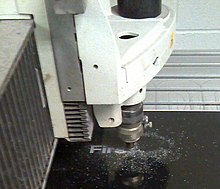
Computerized engraving on Corian.
Engraving machines such as the K500 (packaging) or K6 (publication) by Hell Gravure Systems use a diamond stylus to cut cells. Each prison cell creates one press dot later in the process. A K6 tin can have up to 18 engraving heads each cutting 8.000 cells per 2d to an accuracy of .1 µm and beneath. They are fully computer-controlled and the whole process of cylinder-making is fully automatic.
It is now common place for retail stores (mostly jewellery, silverware or honour stores) to accept a small computer controlled engrave on site. This enables them to personalise the products they sell. Retail engraving machines tend to be focused effectually ease of apply for the operator and the ability to practice a wide variety of items including flat metal plates, jewelry of different shapes and sizes, every bit well as cylindrical items such every bit mugs and tankards. They volition typically be equipped with a computer dedicated to graphic design that will enable the operator to easily design a text or motion picture graphic which the software will translate into digital signals telling the engraver automobile what to practise. Dissimilar industrial engravers, retail machines are smaller and only use one diamond caput. This is interchangeable so the operator can use differently shaped diamonds for unlike finishing furnishings. They volition typically be able to exercise a variety of metals and plastics. Glass and crystal engraving is possible, but the brittle nature of the textile makes the process more than fourth dimension-consuming.
Retail engravers mainly utilise two different processes. The first and most common 'Diamond Drag' pushes the diamond cutter through the surface of the cloth then pulls to create scratches. These management and depth are controlled by the computer input. The second is 'Spindle Cutter'. This is similar to Diamond Drag, but the engraving head is shaped in a apartment V shape, with a small diamond and the base. The machine uses an electronic spindle to rapidly rotate the head as it pushes information technology into the material, then pulls it along whilst it continues to spin. This creates a much bolder impression than diamond drag. It is used mainly for brass plaques and pet tags.
With land-of-the-art mechanism it is piece of cake to have a simple, single item complete in under ten minutes. The engraving process with diamonds is state-of-the-art since the 1960s.
Today laser engraving machines are in evolution but yet mechanical cut has proven its strength in economical terms and quality. More than four,000 engravers make approx. eight Mio printing cylinders worldwide per year.
History [edit]
For the press process, see intaglio (printmaking). For the Western art history of engraved prints, run across old master print and line engraving
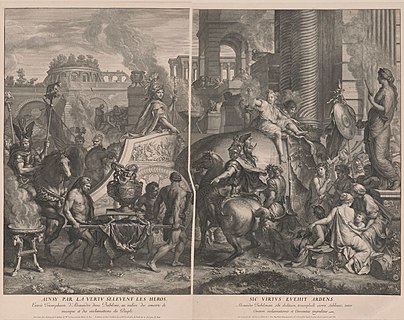
Gérard Audran after Charles LeBrun, Alexander Entering Babylon, original impress kickoff published 1675, engraving
The first bear witness for humans engraving patterns is a chiselled trounce, dating back between 540,000 and 430,000 years, from Trinil, in Java, Indonesia, where the first Homo erectus was discovered.[3] Hatched banding upon ostrich eggshells used every bit water containers establish in South Africa in the Diepkloof Stone Shelter and dated to the Middle Stone Age around sixty,000 BC are the adjacent documented instance of human engraving.[4] Engraving on bone and ivory is an important technique for the Art of the Upper Paleolithic, and larger engraved petroglyphs on rocks are found from many prehistoric periods and cultures effectually the world.
In antiquity, the only engraving on metal that could exist carried out is the shallow grooves found in some jewellery after the beginning of the 1st Millennium B.C. The bulk of so-chosen engraved designs on ancient aureate rings or other items were produced by chasing or sometimes a combination of lost-wax casting and chasing. Engraved gem is a term for any carved or engraved semi-precious stone; this was an important small-scale art grade in the aboriginal earth, and remained pop until the 19th century.

Even so the use of glass engraving, usually using a wheel, to cut decorative scenes or figures into glass vessels, in imitation of hardstone carvings, appears as early as the starting time century Advertizing,[5] continuing into the fourth century CE at urban centers such as Cologne and Rome,[6] and appears to have ceased old in the fifth century. Decoration was first based on Greek mythology, before hunting and circus scenes became popular, as well as imagery drawn from the Old and New Testament.[half dozen] It appears to take been used to mimic the appearance of precious metal wares during the aforementioned period, including the application of gold leaf, and could be cut costless-manus or with lathes. As many as 20 separate stylistic workshops have been identified, and it seems likely that the engraver and vessel producer were split up craftsmen.[five]
In the European Centre Ages goldsmiths used engraving to decorate and inscribe metalwork. Information technology is thought that they began to print impressions of their designs to record them. From this grew the engraving of copper printing plates to produce artistic images on newspaper, known as one-time master prints, in Germany in the 1430s. Italy soon followed. Many early engravers came from a goldsmithing groundwork. The first and greatest period of the engraving was from about 1470 to 1530, with such masters equally Martin Schongauer, Albrecht Dürer, and Lucas van Leiden.

Mod impression of Rembrandt's 1639 cocky-portrait, with the engraving plate.
Thereafter engraving tended to lose basis to etching, which was a much easier technique for the artist to learn. Just many prints combined the two techniques: although Rembrandt's prints are generally all chosen etchings for convenience, many of them have some burin or drypoint work, and some have zippo else. Past the nineteenth century, most engraving was for commercial illustration.
Before the advent of photography, engraving was used to reproduce other forms of art, for example paintings. Engravings continued to be common in newspapers and many books into the early 20th century, every bit they were cheaper to employ in press than photographic images.
Many archetype postage stamp stamps were engraved, although the do is at present mostly bars to particular countries, or used when a more "elegant" design is desired and a limited color range is acceptable.

Modifying the relief designs on coins is a arts and crafts dating back to the 18th century and today modified coins are known colloquially equally hobo nickels. In the United States, especially during the Great Depression, money engraving on the large-faced Indian Caput nickel became a fashion to help make ends encounter. The craft continues today, and with modernistic equipment frequently produces stunning miniature sculptural artworks and floral scrollwork.[7]
During the mid-20th century, a renaissance in hand-engraving began to take identify. With the inventions of pneumatic hand-engraving systems that aided paw-engravers, the art and techniques of hand-engraving became more accessible.
Music engraving [edit]
The first music printed from engraved plates dates from 1446 and near printed music was produced through engraving from roughly 1700–1860. From 1860 to 1990 most printed music was produced through a combination of engraved master plates reproduced through kickoff lithography.
The first comprehensive account is given by Mme Delusse in her commodity "Gravure en lettres, en géographie et en musique" in Diderot's Encyclopedia. The technique involved a five-pointed raster to score staff lines, various punches in the shapes of notes and standard musical symbols, and diverse burins and scorers for lines and slurs. For correction, the plate was held on a bench past callipers, hit with a dot punch on the opposite side, and burnished to remove any signs of the defective work. The process involved intensive pre-planning of the layout, and many manuscript scores with engraver's planning marks survive from the 18th and 19th centuries.[8]
By 1837 pewter had replaced copper as a medium, and Berthiaud gives an account with an entire chapter devoted to music (Novel manuel complet de l'imprimeur en taille douce, 1837). Printing from such plates required a carve up inking to be carried out cold, and the printing press used less pressure level. Mostly, four pages of music were engraved on a unmarried plate. Considering music engraving houses trained engravers through years of apprenticeship, very lilliputian is known about the practice. Fewer than one dozen sets of tools survive in libraries and museums.[ix] Past 1900 music engravers were established in several hundred cities in the world, just the fine art of storing plates was usually concentrated with publishers. Extensive bombing of Leipzig in 1944, the home of most German language engraving and printing firms, destroyed roughly half the world's engraved music plates.
Applications today [edit]

Examples of contemporary uses for engraving include creating text on jewellery, such equally pendants or on the inside of engagement- and wedding ceremony rings to include text such as the proper name of the partner, or calculation a winner'southward proper name to a sports trophy. Some other application of modern engraving is found in the printing industry. There, every day thousands of pages are mechanically engraved onto rotogravure cylinders, typically a steel base with a copper layer of about 0.i mm in which the image is transferred. Afterward engraving the image is protected with an approximately vi µm chrome layer. Using this process the prototype will survive for over a million copies in loftier speed printing presses. Engraving machines such equally GUN BOW (one of the leading engraving brands) are the best examples of hand engraving tools, although this blazon of machine is typically non used for fine hand engraving. Some schools throughout the world are renowned for their teaching of engraving, like the École Estienne in Paris.
Creating tone [edit]

Sudarium of Saint Veronica by Claude Mellan (1649), a famous showpiece where the prototype is formed by a unmarried continuous line, starting on the tip of Christ'south nose.
In traditional engraving, which is a purely linear medium, the impression of half-tones was created by making many very thin parallel lines, a technique called hatching. When two sets of parallel-line hatchings intersected each other for college density, the resulting pattern was known as cross-hatching. Patterns of dots were also used in a technique called stippling, offset used around 1505 past Giulio Campagnola. Claude Mellan was 1 of many 17th-century engravers with a very well-developed technique of using parallel lines of varying thickness (known as the "swelling line") to give subtle furnishings of tone (every bit was Goltzius) – meet picture below. I famous example is his Sudarium of Saint Veronica (1649), an engraving of the face of Jesus fabricated from a single spiraling line that starts at the tip of Jesus's olfactory organ.
Biblical references [edit]
The earliest allusion to engraving in the Bible may be the reference to Judah's seal ring (Ge 38:eighteen), followed by (Ex 39.xxx). Engraving was commonly done with pointed tools of iron or even with diamond points. (Jer 17:i).
Each of the 2 onyx stones on the shoulder-pieces of the high priest'south ephod was engraved with the names of half-dozen different tribes of State of israel, and each of the 12 precious stones that adorned his breastpiece was engraved with the name of one of the tribes. The holy sign of dedication, the shining gold plate on the high priest's turban, was engraved with the words: "Holiness belongs to Adonai." Bezalel, along with Oholiab, was qualified to do this specialized engraving work as well equally to train others.—Ex 35:30–35; 28:9–12; 39:6–14, 30.
Noted engravers [edit]

Prints:
- Jacopo de' Barbari (active 1500–1515)
- William Blake (1757–1827)
- Theodore de Bry (1528–1598)
- Jacques Callot (1592–1635)
- Giulio Campagnola (active c.1505–1515)
- Paul Gustave Doré (1832–1883)
- Albrecht Dürer (1471–1528)
- Maso Finiguerra (1426–1464)
- Hendrick Goltzius (c.1558–1617)
- Francisco de Goya (1746–1828)
- William Hamlin (1772–1869)
- Stanley William Hayter (1901–1988)
- William Hogarth (1697–1764)
- Henry Hulsbergh (?-1729)
- Mauricio Lasansky (1914–2012)
- Lucas van Leyden (1494–1533)
- Andrea Mantegna (c.1431–1506)
- Chief ES (active c.1450–1470)
- Israhel van Meckenem (c.1445–1501)
- Claude Mellan (1598–1688)
- Matthäus Merian (1593–1650)
- Willem Panneels (c.1600–c.1634)
- Alardo de Popma, (1617–1641)
- José Guadalupe Posada (1852–1913)
- Giovanni Battista Piranesi (1720-1778)
- Paulus Pontius (1603 – 1658)
- Rembrandt (1606–1669)
- January Saenredam (1565–1607)
- Nikolaos Ventouras (1899–1990)
- Georg Matthäus Vischer (1628–1696)
- Lucas Vorsterman (1595–1675)
- Anthonie Wierix (1552–1624)
- Hieronymus Wierix (1553–1619)

Of gems:
- Pyrgoteles, Alexander'south gem-engraver
- Theodorus of Samos, Polycrates' gem-engraver
Of guns:
- Malcolm Appleby
- Geoffroy Gournet
Of coins:
- Thomas Hugh Paget
- Leonard Charles Wyon
- William Wyon
Of postage stamp stamps:
- Czesław Słania
- Leonard Charles Wyon
- William Wyon
Of pins:
- Godfrey Lundberg (1879–1933)
Run into also [edit]
- Drypoint – Intaglio printmaking technique
- Intaglio (printmaking) – Family of printing and printmaking techniques
- Laser engraving – Engraving objects using lasers
- Letter cut – Course of inscriptional architectural lettering
- Mezzotint – Printmaking technique
- Le Musée français of Pierre Laurent
- Photogravure – Photographic press technique
- Toreutics – Type of artistic metalworking
- Carving – Act of using tools to shape something from a material by scraping abroad portions of that fabric
- Woodcut – Relief printing technique
- List of stationery topics
References [edit]
- ^ "Abraham Bosse". Bibliothèque nationale de France. 1645. Retrieved 15 July 2008.
- ^ Marcin Latka. "Preparatory drawing for Aegidius Sadeler's print". Archived from the original on 31 March 2019. Retrieved 31 March 2019.
- ^ Globe's oldest engraving discovered, Australian Geographic, 4 December 2014
- ^ Texier PJ, Porraz Yard, Parkington J, Rigaud JP, Poggenpoel C, Miller C, Tribolo C, Cartwright C, Coudenneau A, Klein R, Steele T, Verna C. (2010). "A Howiesons Poort tradition of engraving ostrich eggshell containers dated to sixty,000 years ago at Diepkloof Rock Shelter, S Africa". Proceedings of the National Academy of Sciences Us. doi:10.1073/pnas.0913047107 PMID 20194764
- ^ a b Caron, B., A Roman Figure-Engraved Glass Bowl. Metropolitan Museum Periodical, 1993. 28: p. 47–55.
- ^ a b Fleming, Southward.J., Roman Glass; reflections on cultural alter. 1999, Philadelphia: Academy of Pennsylvania Museum of Archaeology and Anthropology.
- ^ Elaborate Floral Scrollwork Engraved on Coins by Shaun Hughes embellishing existing money faces with different styles of floral scrollwork (2016). Retrieved 27 May 2018
- ^ Poole, H. Edmund (1980). Music Press and Publishing. New York: Norton. pp. forty–54.
- ^ Adventure, William (1923). Music Engraving and Press: Historical and Technical Treatise. London: Pitman.
External links [edit]
![]()
Wikimedia Commons has media related to Engraving.
- Prints & People: A Social History of Printed Pictures, an exhibition catalog from The Metropolitan Museum of Art (fully available online as PDF), which contains material on engraving
- Engraving from The Metropolitan Museum of Art Timeline of Art History
- Engravers Hive
- Engraved Throughout: An Exhibition of Wholly Engraved Books
Which Statement Best Describes Engraving,
Source: https://en.wikipedia.org/wiki/Engraving
Posted by: youngtoomen.blogspot.com


0 Response to "Which Statement Best Describes Engraving"
Post a Comment